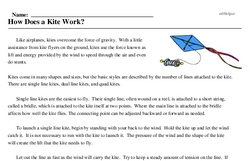How Does a Kite Work?
Like airplanes, kites overcome the force of gravity. With a little assistance from kite flyers on the ground, kites use the force known as lift and energy provided by the wind to speed through the air and even do stunts.
Kites come in many shapes and sizes, but the basic styles are described by the number of lines attached to the kite. There are single line kites, dual line kites, and quad kites.
Single line kites are the easiest to fly. Their single line, often wound on a reel, is attached to a short string, called a bridle, which is attached to the kite itself at two points. Where the main line is attached to the bridle affects how well the kite flies. The connecting point can be adjusted backward or forward as needed.
To launch a single line kite, begin by standing with your back to the wind. Hold the kite up and let the wind catch it. It is not necessary to run with the kite to launch it. The pressure of the wind and the shape of the kite will create the lift that the kite needs to fly.
Let out the line as fast as the wind will carry the kite. Try to keep a steady amount of tension on the line. If your kite line gets tangled with the line of another kite in the air, walk toward the other flyer. The tangle should move down the lines to where you can untangle it. To land a single line kite, reel in the line slowly.




